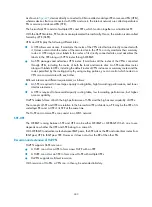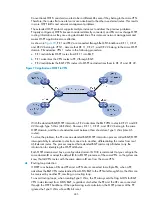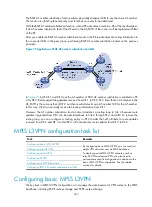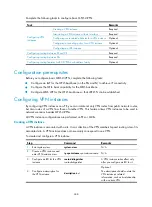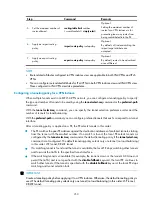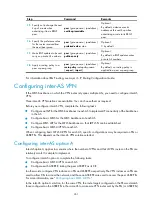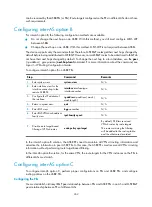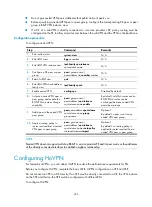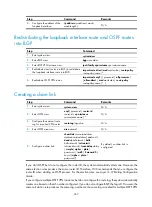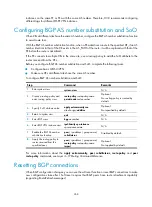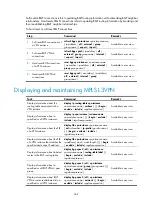
255
Step Command
Remarks
5.
Enter interface view.
interface
interface-type
interface-number
N/A
6.
Enable the IS-IS process on
the interface.
isis enable
[
process-id
]
Disabled by default.
Configuring EBGP between PE and CE
1.
Configure the PE:
Step Command
Remarks
1.
Enter system view.
system-view
N/A
2.
Enable BGP and enter BGP
view.
bgp
as-number
N/A
3.
Enter BGP VPN instance view.
ipv4-family vpn-instance
vpn-instance-name
N/A
4.
Configure the CE as the VPN
EBGP peer.
peer
{
group-name
|
ip-address
}
as-number
as-number
N/A
5.
Redistribute the routes of the
local CEs.
import-route
protocol
[
process-id
]
[
med
med-value
|
route-policy
route-policy-name
] *
A PE must redistribute the routes of
the local CEs into its VPN routing
table so that it can advertise them
to the peer PE.
6.
Configure BGP to filter routes
to be advertised.
filter-policy
{
acl-number
|
ip-prefix
ip-prefix-name
}
export
[
direct
|
isis
process-id
|
ospf
process-id
|
rip
process-id
|
static
]
Optional.
By default, BGP does not filter
routes to be advertised.
7.
Configure BGP to filter
received routes.
filter-policy
{
acl-number
|
ip-prefix
ip-prefix-name
}
import
Optional.
By default, BGP does not filter
received routes.
8.
Allow the local AS number to
appear in the AS_PATH
attribute of a received route
and set the maximum number
of repetitions.
peer
{
group-name
|
ip-address
}
allow-as-loop
[
number
]
Optional.
Required for the hub and spoke
network.
BGP detects routing loops by AS
number. In the hub and spoke
network scheme, with EBGP
running between PE and CE, the
routing information the PE
advertises to a CE carries the
number of the AS where the PE
resides. Therefore, the route
updates that the PE receives from
the CE also include the number of
the AS where the PE resides. This
causes the PE unable to receive the
route updates. In this case, you
must configure this command to
allow routing loops.
2.
Configure the CE:



